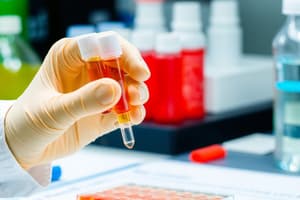Podcast
Questions and Answers
What is the standard concentration of Standard 3 in a serial 1 in 3 dilution from a stock of 1200 ng/ml?
What is the standard concentration of Standard 3 in a serial 1 in 3 dilution from a stock of 1200 ng/ml?
- 44.4 ng/ml
- 133.3 ng/ml (correct)
- 14.8 ng/ml
- 400 ng/ml
Which type of immunoassay requires multiple steps of filtration and washing?
Which type of immunoassay requires multiple steps of filtration and washing?
- Homogenous assay
- Direct immunoassay
- Heterogenous assay (correct)
- Competitive assay
What is the final antibody concentration after performing a 1 in 2000 dilution of a stock concentration of 200 mg/ml?
What is the final antibody concentration after performing a 1 in 2000 dilution of a stock concentration of 200 mg/ml?
- 20 mg/ml
- 0.1 mg/ml (correct)
- 100 mg/ml
- 0.01 mg/ml
What is the antigen concentration after a 1 in 20 dilution from a standard of 2000 ng/ml?
What is the antigen concentration after a 1 in 20 dilution from a standard of 2000 ng/ml?
How many total standards need to be prepared in a serial dilution experiment if starting with a stock of 1200 ng/ml?
How many total standards need to be prepared in a serial dilution experiment if starting with a stock of 1200 ng/ml?
What concentration corresponds to Standard 6 in a serial 1 in 3 dilution from a stock of 1200 ng/ml?
What concentration corresponds to Standard 6 in a serial 1 in 3 dilution from a stock of 1200 ng/ml?
In a homogenous immunoassay, what is a key characteristic?
In a homogenous immunoassay, what is a key characteristic?
What is the correct final volume required to achieve a 1 in 2000 dilution of an antibody stock in an experiment aiming for a total volume of 1 ml?
What is the correct final volume required to achieve a 1 in 2000 dilution of an antibody stock in an experiment aiming for a total volume of 1 ml?
Flashcards
Heterogeneous immunoassay
Heterogeneous immunoassay
A type of immunoassay that requires a separation step before analysis, such as washing or filtration to remove unbound reagents, allowing for more precise measurements.
Homogeneous immunoassay
Homogeneous immunoassay
A type of immunoassay where the reaction occurs in a single step, allowing for quicker results. No separation steps are needed.
Serial dilutions
Serial dilutions
A series of dilutions where the concentration of the substance is decreased by a constant factor in each step.
Calibration standard
Calibration standard
Signup and view all the flashcards
Immunoassay
Immunoassay
Signup and view all the flashcards
Antibody stock concentration
Antibody stock concentration
Signup and view all the flashcards
Dilution
Dilution
Signup and view all the flashcards
Precision
Precision
Signup and view all the flashcards
Study Notes
Immunoassay Data Handling
- Learning Objectives: Data handling, serial dilutions, calibration standard concentrations, antibody stock concentrations, and data handling for precision profiles are key aspects
- Homogenous vs. Heterogenous Assays:
- Homogenous immunoassays: No separation needed before analysis, reagents added together, can be competitive or non-competitive
- Heterogenous immunoassays: Separation required before analysis, multiple steps (filtration, washing, blocking), also competitive or non-competitive, most common type
- Direct Immunoassays: Diagram showing primary antibody binding to antigen (Ag), followed by HRP (Horse Radish Peroxidase) and substrate leading to direct detection
- Serial Dilutions: A 1 in 3 dilution from a 1200ng/ml stock standard is demonstrated to prepare 7 standards for a quantitative ELISA experiment. The calculation shows the concentrations for standards 3 and 6
- Calibration Standard Concentrations: Calculation for antigen concentration after dilutions, demonstrates a 2000ng/ml antigen standard after performing 1 in 200, 1 in 360, and 1 in 20 dilutions
- Indirect Immunoassays: Diagram illustrating the two-step process, involving primary and secondary antibodies to detect antigen, showing use of HRP and a substrate, leading to indirect detection
- Antibody Stock Concentration: A 200mg/mL antibody stock is diluted 1 in 2000. This leads to a final antibody concentration of 0.1 mg/mL (or 100 μg/mL), and 0.5 mL of the antibody is required for a 1 mL final volume
- Precision: Calculation demonstrates a precision study for standard 3, finding the %CV (coefficient of variation) of absorbance readings from 10 technical replicates for a standard. Mean and standard deviation values are crucial.
- Precision Profiles: Diagram explains sensitivity in terms of dynamic range of the assay
- Sources of Imprecision: Factors influencing accuracy in immunoassays, including reagents (antibodies, calibrators, etc.), Ab:Ag reaction conditions, enzyme substrate reaction, detection apparatus (plate reader, filters), and potential interference effects like the high dose hook effect
Studying That Suits You
Use AI to generate personalized quizzes and flashcards to suit your learning preferences.




